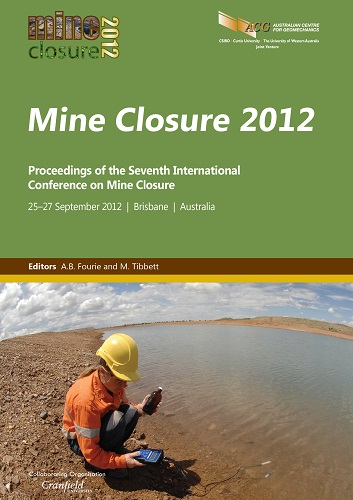Closure planning and decommissioning of tailings storage facilities

|
Authors: Bennett, KE; Lacy, HWB |
DOI https://doi.org/10.36487/ACG_rep/1208_14_Bennett
Cite As:
Bennett, KE & Lacy, HWB 2012, 'Closure planning and decommissioning of tailings storage facilities', in AB Fourie & M Tibbett (eds), Mine Closure 2012: Proceedings of the Seventh International Conference on Mine Closure, Australian Centre for Geomechanics, Perth, pp. 139-148, https://doi.org/10.36487/ACG_rep/1208_14_Bennett
Abstract:
A major driver for improved planning in closure and decommissioning of tailing storage facilities (TSFs) is the numerous TSF legacies that exist around the world. Tailings are a combination of any remaining process water and the fine grained solid material remaining after the recoverable metals and minerals have been extracted from the treated ores and placed in a containment area. The physical and chemical composition of tailings varies with the nature of the material being processed, and the process itself. These differences, along with the location of the operation, will dictate the level of management required for the tailings and for the TSF during construction, deposition and closure. Tailings may be stored in a variety of ways, depending on their geochemical properties, the site topography, climatic conditions and the socio-economic context in which the mine and mill operations are located. TSFs are often viewed as the most difficult issue to resolve in mine closure. This can be mitigated by ensuring tailings closure planning occurs progressively throughout the life of the mine and a robust decommissioning process is followed. It is imperative that closure planning is an integral component of planning, design, construction, operations, closure and decommissioning. The development of leading practice tailings management is becoming increasingly more rigorous both nationally and internationally. The importance of designing a sustainable TSF landform and managing construction with the end in mind is recognised within the May 2011 ANCOLD Draft Guidelines on Tailings Dams – Planning, Design, Construction, Operation and Closure. The 2011 ANCOLD Guidelines highlight the important principle of designing, constructing and operating a TSF with an aim to an eventual closure strategy that will allow a safe and stable structure to remain following the completion of mining operations. Post-closure, a TSF must be able to cope with stochastic events and change likely to be encountered over an extended period determined as per the design life, potentially of 1,000 years or longer. This paper will link the 2011 ANCOLD Guidelines to the critical factors that impact on the decommissioning and final rehabilitation of a TSF, including the opportunity to use risk assessment techniques to identify (design out), and manage closure challenges and risks at the beginning. Robust decommissioning planning as a part of tailings management will be discussed, increasing the awareness that closure is a process not an event.
References:
ANCOLD (2011) Australian National Committee on Large Dams. Draft Guidelines on Tailings Dams – Planning, Design, Construction, Operation and Closure, 34 p., viewed 16/07/2012, .
AS/NZS ISO 31000:2009 (2009) Risk management – Principles and Guidelines.
DEWHA (1992) Department of the Environment, Water, Heritage and the Arts. Intergovernmental Agreement on the Environment, viewed 10/07/2012, .
DITR (2007) Department of Industry, Tourism and Resources. Tailings Management, Leading Practice Sustainable Development Program for the Mining Industry 88 p., viewed 30/06/2012, .
DRET (July 2011) Department of Resources, Energy and Tourism. A Guide to Leading Practice Sustainable Development in Mining, Leading Practice Sustainable Development Program for the Mining Industry, 210 p., viewed 30/06/2012, .
Envec, Environment Security Initiative (2005) Mining for Closure. Policies and Guidelines for Sustainable Mining Practice and Closure of Mines, South East Europe, UNEP, UNDP, OSCE, NATO.
Environment Australia (1999) Environmental risk management, Best Practice Environmental Management in Mining Series, Environment Australia, Canberra.
ICOLD (2001) International Commission on Large Dams. Bulletin 121 on Tailings Dams — Risk of Dangerous Occurrences.
ICOLD (2010) International Commission on Large Dams. Bulletin 153 on Sustainable Design and Post-Closure Performance of Tailings Dams, currently.
Jones, H., Lacy, H. and Watkins, R. (2006) Reclamation/rehabilitation and closure of tailing storage facilities, in Paste and Thickened Tailings ‒ A Guide, 2nd edition, R.J. Jewell and A.B. Fourie (eds), Australian Centre for Geomechanics, Perth, Sec 11.8.
Lacy, H. and Barnes, K. (2006) Tailings Storage Facilities Decommissioning Planning is vital for successful closure, in Proceedings First International Seminar on Mine Closure (Mine Closure 2006), A.B. Fourie and M. Tibbett (eds), 13‒15 September 2006, Perth, Australia, Australian Centre for Geomechanics, Perth, pp. 139–148.
Lacy, H. and Campbell, G. (2000) Decommissioning Tailings Storage Facilities: The challenges and how they are being met during closure of a NickelSulphide Mine in Western Australia, Minerals Council of Australia, 4th International and 25th National Environmental Workshop (2000), Conference Proceedings Perth, Western Australia.
Lacy, H. and Ward, J. (1998) Rehabilitation in relation to decommissioning of tailings storage facilities in Western Australia: challenges and solutions, in Short Course Proceedings Tailings Management and Decommissioning (Course No. COR 9810), December 1998, Perth, Australia, Australian Centre for Geomechanics, Perth.
MCMPR/MCA (2003) Ministerial Council on Mineral and Petroleum Resources; Minerals Council of Australia. Strategic Framework for Tailings Management, National Capital Printing, Canberra.
UNWCED (1987) United Nations World Commission on Environment and Development. Our Common Future, Oxford: Oxford University Press.
WMI (1994) Whitehorse Mining Initiative. Environment Issues Group, Final Report, October 1994 (as referenced in ANZMEC/MCA, 2000).
© Copyright 2025, Australian Centre for Geomechanics (ACG), The University of Western Australia. All rights reserved.
View copyright/legal information
Please direct any queries or error reports to repository-acg@uwa.edu.au
View copyright/legal information
Please direct any queries or error reports to repository-acg@uwa.edu.au